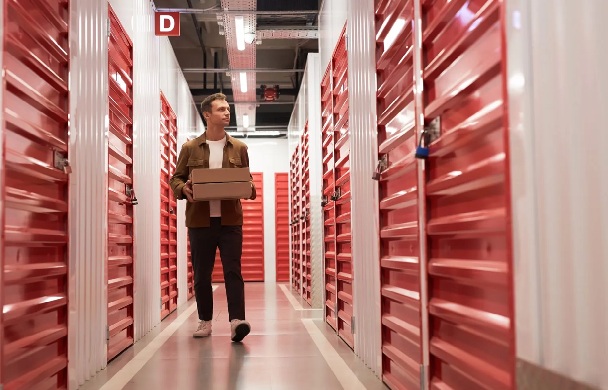
With four sites dotted across north and west London and a fifth in the pipeline, Metro Storage has been attracting plenty of attention from property investors.

“We are approached on a fairly regular basis,” says Angus Burnett, co-founder of the company alongside his brother Simon. “At the moment it suits us to run the business ourselves – but never say never.”
Metro is far from alone in being targeted. This year’s Self Storage Annual Report, produced by the Self Storage Association (SSA) in conjunction with property consultancy Cushman & Wakefield (C&W), highlights 11 mergers and acquisitions in 2024.
These included Shurgard’s £408m purchase of rival Lok’nStore last August and private equity outfit Paloma Capital’s acquisition of Pink Hippo Self Storage for an undisclosed fee in October, to add to its Wigwam Storage Management brand.
Meanwhile, a number of investors are believed to have placed offers for Access Self Storage’s network of 60 UK sites.
The SSA report states that the sector is witnessing “a surge in institutional interest”, with mature portfolios attracting capital. C&W notes that there was £500m of self-storage merger and acquisition activity in 2024, compared with £300m in 2023. Burnett says investors are increasingly looking to add the once-niche sector to their portfolios. But building from scratch is difficult.
“More big funds are getting into the sector,” he says. “People are saying they have hundreds of millions to invest, but often they struggle to find the right sites to do that.”
This has led to increased investor appetite for acquiring existing facilities, despite a fall in customer demand across the self-storage market in recent years. Occupation rates peaked at 83% in 2021 during the Covid-19 outbreak, then slipped back to 75% in 2024, according to the SSA’s report.
“We have returned to pre-Covid business patterns,” says Burnett. “During the pandemic it was always good. But peaks and troughs are back. For us, average length of stay is down, so value per customer is down.
“People are staying for less time because of the cost of living; they are watching their budgets and being efficient at giving their notice after the events they needed us for.”
With increased competition for customers, Metro’s conversion rates from online marketing have come down. “One operator is offering 50% off 17 weeks of storage, which is unprecedented,” adds Burnett. “It makes it harder to put our rents up.”

Takeover target: Lok’nStore was bought by rival Shurgard in a £408m deal last August
Despite this comedown from the lockdown-generated frenzy for space, Metro is still looking to grow. “We are working on a deal with a London council to convert an underground car park,” says Burnett. “Hopefully, this year we will open our
fifth store.
“If you get the right price in the right location, there is a business to run. It won’t be without its challenges, but it sits well in our portfolio.”
Exceptional customer service is key
Getting your offering spot-on is critical for new stores, he stresses. “With increased competition, exceptional customer service is important,” says Burnett. “Technology is also changing rapidly. Artificial intelligence [AI] monitoring CCTV has been a game-changer for us by adding a massive security dimension to what we had before.”
More than half of respondents to a survey cited in the SSA report use AI in this way.
Steffan Morgan, partner and self-storage specialist at C&W, says institutional investors are increasingly attracted to the self-storage sector. “Consolidation and institutionalisation are the buzzwords,” he adds. “We are talking about a resilient sector that is becoming sticky to the end user.”
Traditionally, consumers have used self-storage facilities for limited periods during life events such as home moves. However, self-storage is now also used for storing household possessions over the longer term. “This part of the sector – people who will use self-storage regularly over a period of time – is increasing,” says Morgan.
Self-storage is by far the fastest-growing sector since 2005
Daryl Perry, Cushman & Wakefield
Although occupancy across the sector dropped to 75% in 2024, the figure for mature stores – those that have been open at their current capacity for at least four years – stood at 79%, just half a percentage point below its 2023 level. The sector’s revenue per square foot also grew 6% to £29.13.
Morgan points out that more than 4m sq ft of self-storage space opened in the UK last year. “That will still be filling up,” he says. “Those guys will be managing yield by driving rental rates forward, which is far easier to do with new [rather] than existing customers.”
Daryl Perry, head of research and insight at C&W, adds that occupancy levels grew in 2024 for mature stores in some parts of the UK, including Scotland, the West Midlands and northern England.
Meanwhile, occupancy rates were up last year in most of England and notably in London.
Societal shifts
“The self-storage sector is by far the fastest-growing sector since 2005, albeit from a relatively small base,” Perry adds. “We see it continuing to grow at a significant rate. Institutions are looking to capture behavioural shifts in society: population growth; more people living in city centres; less space. Self-storage enables you to do that.”
Ultimately, Morgan says, consistent financial performance is driving investor interest. “It is the promise of higher returns than in traditional sectors,” he adds.
“Self-storage is in a maturing arc and there is an opportunity to grow portfolios for a lucrative exit.”
Classed as a ‘B8’ development in planning terms, self-storage is part of the in-demand industrial sector, yet it offers clear advantages compared with warehouses and logistics parks, Morgan adds. “You don’t have to acquire as much land; you can stack it high and maximise the value you get back.”

He also argues that investors will be hunting for opportunities to build new sites as well as collect existing ones. “At a certain scale, you can lower your cost base, push up your margin and maximise the return from your exit,” he explains. “First- and second-generation stores that are family owned and regionally based will be snapped up where suitable.”
Steve Wells, operations director at self-storage property and operations specialist Flexiss Group, predicts that there will be further “moderate growth” in the sector over the coming year.
He says it has proved to be resilient to global shocks and economic conditions while operational costs are coming down, partly because new technology allows stores to be staffed by fewer people.
Flexiss this spring announced a £300m partnership with Compound Real Estate to build a self-storage portfolio in the South East. The venture secured five sites and had two more under offer.
In May, the firm revealed that it would operate a SureStore facility in a former car showroom in Doncaster, after the site was acquired by Barwood Capital.
Wells says further expansion is planned. “Our growth will come predominantly from new builds as we see a surge in institutional interest,” he says.
Wells believes AI will play an increasingly vital role in self-storage. “There is a shift to purpose-built, tech-driven facilities, which might see an increase in remote and semi-remote facility operations, with the introduction of smart access, AI surveillance and operational automation,” he says.
Getting to the forefront of these trends could be critical for operators in the sector, Wells argues. “Operators will face pricing pressure this year, especially in areas where a new facility opens or where there is a competitor with an aggressive pricing model,” he says.
“Rents will be flat in most regions, but I expect operators that embrace digital technology to outperform the industry again in unit rental prices.”
Self-storage in numbers
- 64.3m sq ft
Total amount of self-storage space in the UK last year - 2,915
Total number of stores - £29.13
Average revenue per sq ft - £1.2bn
Overall turnover of the main sector operators - 75%
Average occupancy rate - 2.6
Average number of staff per store
Source: Self-Storage Annual Report 2025




 Follow us on Twitter
Follow us on Twitter
 Follow us on LinkedIn
Follow us on LinkedIn
